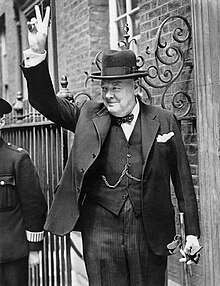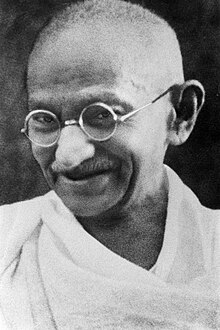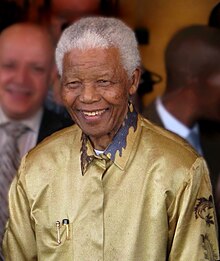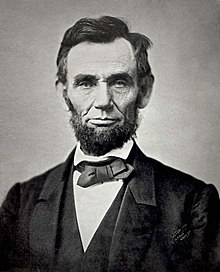Courage: Difference between revisions
Crazytonyi (talk | contribs) No edit summary Tag: Mobile edit |
m Added a section on Moral Courage |
||
| Line 55: | Line 55: | ||
According to [[Maya Angelou]]:<blockquote>Courage is the most important of the virtues, because without courage you can't practice any other virtue consistently. You can practice any virtue erratically, but nothing consistently without courage.</blockquote>Or this insight from [[Winston Churchill]]:<blockquote>Courage is rightly esteemed the first of human qualities ... because it is the quality that guarantees all others.</blockquote> |
According to [[Maya Angelou]]:<blockquote>Courage is the most important of the virtues, because without courage you can't practice any other virtue consistently. You can practice any virtue erratically, but nothing consistently without courage.</blockquote>Or this insight from [[Winston Churchill]]:<blockquote>Courage is rightly esteemed the first of human qualities ... because it is the quality that guarantees all others.</blockquote> |
||
== Moral Courage == |
|||
Moral Courage is the willingness to stand up when others want you to sit down.<ref>{{cite web|last=Wagner|first=NYU|title=Moral Courage Project|url=http://wagner.nyu.edu/leadership/affiliates/moral_courage|publisher=NYU|accessdate=6 October 2013}}</ref> The project was founded by [[Irshad Manji]] to promote honest dialogue about diversity, faith, sexuality and ethics amongst leaders in the workplace, at school and in communities. Most recently, in partnership with You Tube, the Moral Courage Project launched [http://www.youtube.com/watch?v=WVDCSU3hkPk Moral Courage TV] showcasing everyday examples of moral courage. |
|||
== Symbolism == |
== Symbolism == |
||
Revision as of 21:08, 6 October 2013
This article has multiple issues. Please help improve it or discuss these issues on the talk page. (Learn how and when to remove these messages)
No issues specified. Please specify issues, or remove this template. |

Courage is the ability and willingness to confront fear, pain, danger, uncertainty, or intimidation. Physical courage is courage in the face of physical pain, hardship, death, or threat of death, while moral courage is the ability to act rightly in the face of popular opposition, shame, scandal, or discouragement.
In some traditions, fortitude holds approximately the same meaning as courage. In the Western tradition, notable thoughts on courage have come from philosophers such as Aristotle, Aquinas and Kierkegaard; in the Eastern tradition, some thoughts on courage were offered by the Tao Te Ching. More recently, courage has been explored by the discipline of psychology.
Theories of courage
Western antiquity and the Middle Ages
Ancient Greece
There is a tradition moving back to Ancient Greek philosophy for counting courage or fortitude as one of the four cardinal virtues, along with prudence, justice, and temperance. ("Cardinal" in this sense means "pivotal"; it is one of the four cardinal virtues because to possess any virtue, a person must be able to sustain it in the face of difficulty.)
As a desirable quality, courage is discussed broadly in Aristotle's Nicomachean Ethics, where its vice of shortage is cowardice and its vice of excess is recklessness.[1]
Ancient Rome
In the Roman Empire, courage formed part of the universal virtue of virtus.[2] Roman philosopher and statesman Cicero (106–43 BC) lists the cardinal virtues, but does not name them such:
"Virtue may be defined as a habit of mind (animi) in harmony with reason and the order of nature. It has four parts: wisdom (prudentiam), justice, courage, temperance." (De Inventione, II, LIII)
Medieval philosophy
In medieval virtue ethics, championed by Averroes and Thomas Aquinas and still important to Roman Catholicism, courage is referred to as "Fortitude".[3]
According to Thomas Aquinas,[4]
Among the cardinal virtues, prudence ranks first, justice second, fortitude third, temperance fourth, and after these the other virtues.
Part of his justification for this hierarchy is that
Fortitude without justice is an occasion of injustice; since the stronger a man is the more ready is he to oppress the weaker.
On fortitude's general and special nature, Aquinas says,[5]
the term "fortitude" can be taken in two ways. First, as simply denoting a certain firmness of mind, and in this sense it is a general virtue, or rather a condition of every virtue, since as the Philosopher states (Ethic. ii), it is requisite for every virtue to act firmly and immovably. Secondly, fortitude may be taken to denote firmness only in bearing and withstanding those things wherein it is most difficult to be firm, namely in certain grave dangers. Therefore Tully says (Rhet. ii), that "fortitude is deliberate facing of dangers and bearing of toils." On this sense fortitude is reckoned a special virtue, because it has a special matter.
Aquinas holds fortitude or courage as being primarily about endurance, not attack:[6]
As stated above (Article 3), and according to the Philosopher (Ethic. iii, 9), "fortitude is more concerned to allay fear, than to moderate daring." For it is more difficult to allay fear than to moderate daring, since the danger which is the object of daring and fear, tends by its very nature to check daring, but to increase fear. Now to attack belongs to fortitude in so far as the latter moderates daring, whereas to endure follows the repression of fear. Therefore the principal act of fortitude is endurance, that is to stand immovable in the midst of dangers rather than to attack them.
Christianity
In both Catholicism and Anglicanism, courage is also one of the seven gifts of the Holy Spirit.
Eastern traditions
The Tao Te Ching states that courage is derived from love ("慈 loving 故 causes 能 ability 勇 brave") and explains: "One of courage, with audacity, will die. One of courage, but gentle, spares death. From these two kinds of courage arise harm and benefit."[7][8]
Courage (shauriya) and Patience (dhairya) appear as the first two of ten characteristics (lakshana) of dharma in the Hindu Manusmṛti, besides forgiveness (kshama), tolerance (dama), honesty (asthaya), physical restraint (indriya nigraha), cleanliness (shouchya), perceptiveness (dhi), knowledge (vidhya), truthfulness (satya), and control of anger (akrodh).
Islamic beliefs also present courage and self-control as a key factor in facing the Devil and in some cases Jihad to a lesser extent; many believe this because of the courage (through peace and patience) the Prophets of the past displayed against people who despised them for their beliefs.
Modernity

Søren Kierkegaard opposed courage to angst, while Paul Tillich opposed an existential courage to be to non-being, fundamentally equating it with religion:
- "Courage is the self-affirmation of being in spite of the fact of non-being. It is the act of the individual self in taking the anxiety of non-being upon itself by affirming itself ... in the anxiety of guilt and condemnation. ... every courage to be has openly or covertly a religious root. For religion is the state of being grasped by the power of being itself."[9]
J.R.R. Tolkien identified in his 1936 lecture "Beowulf: The Monsters and the Critics" a "Northern 'theory of courage'"—the heroic or "virtuous pagan" insistence to do the right thing even in the face of certain defeat without promise of reward or salvation:
It is the strength of the northern mythological imagination that it faced this problem, put the monsters in the centre, gave them victory but no honor, and found a potent and terrible solution in naked will and courage. 'As a working theory absolutely impregnable.' So potent is it, that while the older southern imagination has faded forever into literary ornament, the northern has power, as it were, to revive its spirit even in our own times. It can work, as it did even with the goðlauss Viking, without gods: martial heroism as its own end.[10]
Virtuous pagan heroism or courage in this sense is "trusting in your own strength," as observed by Jacob Grimm in his Teutonic Mythology,
Men who, turning away in utter disgust and doubt from the heathen faith, placed their reliance on their own strength and virtue. Thus in the Sôlar lioð 17 we read of Vêbogi and Râdey â sik þau trûðu, "in themselves they trusted"[11]
Ernest Hemingway famously defined courage as "grace under pressure."[12]
According to Maya Angelou:
Courage is the most important of the virtues, because without courage you can't practice any other virtue consistently. You can practice any virtue erratically, but nothing consistently without courage.
Or this insight from Winston Churchill:
Courage is rightly esteemed the first of human qualities ... because it is the quality that guarantees all others.
Moral Courage
Moral Courage is the willingness to stand up when others want you to sit down.[13] The project was founded by Irshad Manji to promote honest dialogue about diversity, faith, sexuality and ethics amongst leaders in the workplace, at school and in communities. Most recently, in partnership with You Tube, the Moral Courage Project launched Moral Courage TV showcasing everyday examples of moral courage.
Symbolism
Its accompanying animal is the lion. Often, fortitude is depicted as having tamed the ferocious lion. Cf. e.g. the Tarot trump called Strength. It is sometimes seen in the Catholic Church as a depiction of Christ's triumph over sin (see Revelation 5:5). It also is a symbol in some cultures as a savior of the people who live in a community with sin and corruption.
Awards
- See also Category:Courage awards
Several awards claim to recognize courageous actions, including:
- The Victoria Cross is the highest military award that may be received by members of the armed forces in the British Army and other Commonwealth countries for valour "in the face of the enemy." A total of 1,356 have been awarded to individuals, 13 since World War II.
- The Medal of Honor is the highest military decoration awarded by the United States government. It is bestowed on members of the United States armed forces who distinguish themselves "conspicuously by gallantry and intrepidity at the risk of his life above and beyond the call of duty while engaged in an action against an enemy of the United States”.
- Distinguished Service Cross (United States) is the second highest military decoration that can be awarded to a member of the United States Army, awarded for extreme gallantry and risk of life in actual combat with an armed enemy force.
- The Carnegie Hero Fund - was established to recognize persons who perform extraordinary acts of heroism in civilian life in the United States and Canada, and to provide financial assistance for those disabled and the dependents of those killed saving or attempting to save others.
- The Profile in Courage Award is a private award given to recognize displays of courage similar to those John F. Kennedy described in his book Profiles in Courage. It is given to individuals (often elected officials) who, by acting in accord with their conscience, risked their careers or lives by pursuing a larger vision of the national, state or local interest in opposition to popular opinion or pressure from constituents or other local interests.
- The Civil Courage Prize is a human rights award which is awarded to "steadfast resistance to evil at great personal risk — rather than military valor." It is awarded by the Trustees of The Train Foundation annually and may be awarded posthumously.
- Courage to Care Award is a plaque with miniature bas-reliefs depicting the backdrop for the rescuers' exceptional deeds during the Nazis' persecution, deportation and murder of millions of Jews.
- The Ivan Allen Jr. Prize for Social Courage is a prize awarded by Georgia Institute of Technology to individuals who uphold the legacy of former Atlanta Mayor Ivan Allen Jr., whose actions in Atlanta, Georgia and testimony before congress in support of the 1963 Civil Rights Bill legislation set a standard for courage during the turbulent civil rights era of the 1960s.
- The Param Vir Chakra is the highest military award in India given to those who show the highest degree of valour or self-sacrifice in the presence of the enemy. It can be, and often has been, awarded posthumously.
As a strength in psychology
From the end of the 20th century, courage has been a concept generating interest in the field of psychology. In 2004, Christopher Peterson and Martin Seligman's book, Character Strengths and Virtues, proposed a uniform way of classifying positive traits that highlight the elements of humanity that uplift humanity, Courage being among the key virtues. In addition, Seligman and Peterson founded the Virtues in Action (VIA) Institute and created the VIA survey which hope to bring this uniform categorization of human strengths to the masses. The VIA classifies human strengths in six, broad categories: Wisdom and Knowledge, Courage, Humanity, Justice, Temperance, Transcendence. Courage is broken down into four main subcategories: Bravery, Perseverance, Honesty, and Zest.

Bravery
Bravery is the subcategory most people generally associate with courage.[14] It is defined as "the ability to stand up for what is right in difficult situations".[14] As opposed to less sophisticated definitions that simply categorize bravery as fearlessness or acting when an observer would be afraid.[15] There are several forms of this bravery. Physical bravery involves acting in spite of possible harm to one's body. Moral bravery involves acting in a way that enhances what one believes to be good in spite of social disapproval and possible backlash. A third, theoretically newer, definition of bravery is psychological bravery which involves things such as overcoming one's own addictive habits, irrational anxieties, and harmful dependent relationships. Psychological bravery means acting against one's own natural inclinations and facing fears which might not have any societal moral implications.[16] Bravery works well as a virtue in the VIA classification system because it is highly regarded across cultures and has obvious benefits for those surrounded by brave people. Possible problems with viewing bravery as a classifiable human strength is that it could be argued that bravery is not trait-like since it only comes out under certain circumstances.[14] The counterargument to this claim is that bravery is trait-like in the same way creativity is considered a trait; both appear only in certain situations.[14] The VIA claims that it is a positive psychological trait that can be found and cultivated in certain individuals.

Perseverance
Perseverance falls under the larger category of courage because it often involves continuing along a path in the midst of and after having faced opposition and perhaps failure. Perseverance involves the ability to seek a goal in spite of obstacles and has been shown in human and animal studies to be a lasting trait with individual differences.[17] In order to persevere at a task, a person must be able to suppress desires to give up and pursue an easier task, a metacognitive understanding that the ends justify the persevering means. But beyond meta cognition, a person high in perseverance is able to overcome low self-esteem and estimations that one cannot do the task as well as discouragement from peers and the desire to present oneself well.[18] As a categorical psychological strength, perseverance is regarded highly by society as opposed to laziness. However, its one weakness as an entry on the VIA as noted by Peterson and Seligman is that it may not be discernible from other human strengths and virtues. It especially can be seen as overlapping with self-control. However, Peterson and Seligman maintain its distinctiveness, pointing out that perseverance "is explicitly shown across time, whereas control and regulation of oneself have a more here-and-now flavor".[14] More research needs to be done in this area to show empirically that perseverance belongs in its own distinct category.

Honesty
As defined by positive psychologists, honesty and authenticity as a subset of courage means more than simply telling the truth. It involves integrity in all areas of one's life and the ability to be true to oneself and one's role in the world across circumstances.[14] Though perhaps one would not immediately associate honesty with courage, there are obvious situations in life where to be honest and authentic requires a great deal of strength in the midst of fear. The positive view societies have of honesty can be seen from the fact that it is something people try to develop in young children and adolescents.[14] While all people seem to grow in their understanding of the moral importance of honest and integrity as they grow older,[19] there are certain individuals who seem to especially excel in this human strength. This trait is important in many areas of life, so much so that many measurements have been developed in an effort to identify especially honest individuals. These measurements test both overt honesty, the thoughts one has about blatant dishonesty such as stealing, and covert honesty, which is very similar to conscientiousness and dependability.[14] Of all the subcategories under courage in the VIA, Honesty shows the most promise as a distinct, well defined area of classification.[14]

Zest
Of the four categories involved in courage, zest or vitality, is the one that has the most weaknesses as a classification. It is defined as, "feeling alive, being full of zest, and displaying enthusiasm for any and all activities".[14] This is a category that is influenced not only by subjective psychological factors, but also objective factors affecting one's physical well-being such as chronic pain.[20] The reason Peterson and Seligman group Zest together with other courageous virtues is that Zest most often comes forth as a character strength in the midst of trying circumstances. For example, it has been shown that people's subjective perception of their situation when faced with chronic pain, judging their perceived ability to handle the situation and their general positivity, is able to influence their well-being. This zest can be shown to be trait-like across situations.[20]
See also
Notes
- ^ Aristotle, Nichomachean Ethics, 1103b15-20, 1104a15-25, 1104b1-10, 1107a30-1107b5, 1108b15-35, 1109a5-15, 1115a5-1117b25, 1129b20-5, 1137a20-5, 144b5-10, 1167a20, 1177a30-b1, 1178a10-5, 1178a30-5, 1178b10-5, in Aristotle, Translation, Introduction, and Commentary, Broadie, Sarah, & Rowe, C., Oxford University Press, 2002.
- ^ Myles McDonnell; Roman Manliness
- ^ CCEL.org
- ^ Summa Theologica: Fortitude (Secunda Secundae Partis, Q. 123)
- ^ Summa Theologica: Fortitude (Secunda Secundae Partis, Q. 123)
- ^ Summa Theologica: Fortitude (Secunda Secundae Partis, Q. 123)
- ^ Chapter 67 and 73, Tao Te Ching (C. Ganson uses the word "courage", but the Mitchell translation does not.)
- ^ Zhonwen.com, Tao Te Ching with Hanzi translations
- ^ Tillich, Paul (1952). The Courage To Be. London: Collins. 152–183.
- ^ Tolkien, JRR. "Beowulf: The Monsters and the Critics". The Tolkien Estate. p. 25. Archived from the original on 2007-10-15. Retrieved 2008-04-25.
- ^ Grimm, Jacob (1835). Deutsche Mythologie (Teutonic Mythology) (in German) (1 ed.). Dieterich: Göttingen.
- ^ Carter, Richard. "Celebrating Ernest Hemingway's Century". neh.gov. National Endowment for the Humanities. Retrieved 2009-06-19.
- ^ Wagner, NYU. "Moral Courage Project". NYU. Retrieved 6 October 2013.
- ^ a b c d e f g h i j Peterson, 2004
- ^ Evans, 1981
- ^ Putman, 1997
- ^ Eisenberger, 1992
- ^ Zimmerman, 1995
- ^ Bussey, 1992
- ^ a b Ryan, 1997
References
- Jeanmart, G.; Blésin, L. (dir.), Figures du courage politique dans la philosophie moderne et contemporaine, numéro thématique de la revue Dissensus. Revue de philosophie politique de l'Université de Liège (http://popups.ulg.ac.be/dissensus/), n°2, automne 2009.
- Avramenko, Richard (2011). Courage: The Politics of Life and Limb. University of Notre Dame Press.
- Catholic Encyclopedia "Fortitude"
- Summa Theologica "Second Part of the Second Part" See Questions 123–140
- Becker, Ernest (1973). The Denial of Death. New York: The Free Press.
- Walton, Douglas N. (1986). Courage: A Philosophical Investigation. Los Angeles: University of California Press.
- Palmquist, Stephen (2000). "Angst and the Paradox of Courage" hkbu.edu.hk, Chapter XII in The Tree of Philosophy. Hong Kong: Philopsychy Press.
- Bussey, K. (1992). "Lying and truthfulness: Children's definitions, standards, and evaluative reactions". Child Development, 63, 129–137.
- Deci, E. L.; Ryan, R. M. (2000). "The 'what' and 'why' of gal pursuits: Human needs and the self-determination of behavior. Psychological Inquiry', 4, 227–268.
- Eisenberger, R. (1992). "Learned industriousness". Psychological Review, 99, 248–267.
- Evans, P. D.; White, D. G. (1981). "Towards an empirical definition of courage". Behaviour Research and Therapy, 19, 419–424.
- Peterson, C.; Seligman M. E. P. (2004). Character Strengths and Virtues: A Handbook and Classification. New York: Oxford University Press. 197–289.
- Putnam, D. (1997). "Psychological courage". Philosophy, Psychiatry, and Psychology, 4, 1–11.
- Ryan, R. M.; Frederick, C. (1997). "On energy, personality, and health: Subjective vitality as a dynamic reflection of well-being". Journal of Personality, 65, 529–565.
- Zimmerman, Barry J. (1995). Self-regulation involves more than meta cognition: A social cognitive perspective. Educational Psychologist. pp. 30, 217–221.
- Ian Miller, William (2000). The Mystery of Courage. Cambridge, Massachusetts: Harvard University Press. ISBN 0-674-00826-X.
External links
- Courage Institute International, Share insights about building your own courage or ennobling teams to lift performance with courage.
- Moral Courage Television, Moral Courage TV tells the stories of individuals from various backgrounds who stand up when others sit down.


